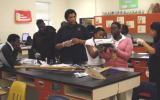Student Retention

Like most community colleges across the U.S., Kirkwood Community College embodies the widely celebrated educational ideal that it’s never too late to get a college education. This ideal is on display every day at 10 campuses spread out over the college’s seven-county service area in eastern Iowa. In fact, the age range for enrolled, degree-seeking students at the college is from 16 to 74 years old, and that range grows even wider when dual enrollment numbers are considered.
When Kirkwood first opened its doors in 1966, the educational delivery format was the same for every student, no matter...

Those at Moraine Valley Community College (MVCC) in Palos Hills, Illinois, believe that the measure of student success is best determined by the students themselves. With that in mind, the college’s Completion Commitment Committee implemented several initiatives, including a Retention Academy, to help students reach their goals.
Student success can be completion of a degree, but it can also be completing a class or achieving a passing grade. “Of course, when we talk about completion, we want students to earn a degree, but that’s not the only way they are successful,” said Dr. Margaret Lehner...

As much as the faculty, classified professionals, and administration at San Diego City College take pride in the 1,500 classes and 200+ degree and certificate programs offered at the 60-acre urban campus, they also understand that the college’s role in supporting and empowering students goes far beyond the classroom. For instance, thirty-nine percent of college students experience significant mental health issues, yet two-thirds with anxiety or depression do not seek treatment (Active Minds, n.d.). Even more alarming is the fact that suicide is the second leading cause of death among college...
Tags:

In 2014, as part of the Accelerated Study in Associate Programs (ASAP) Ohio Demonstration, Lorain County Community College launched Students Accelerating in Learning (SAIL), a comprehensive student success program that is substantially improving persistence and graduation rates among low-income students. Given the program’s results, Lorain has committed to sustaining the program and expanding it to serve most of its low-income student population. If the college achieves this goal, it could close attainment gaps between low-income and more affluent students, markedly boost its overall...
Tags:

It’s crunch time on campus at Onondaga Community College (OCC). Spring semester final exams are just over a week away. In Professor Kristen Costello’s Microeconomics (ECO 204) class she’s discussing final project options with students. “You can do either a paper or a presentation,” Costello said. “If you choose a presentation you can do so as an individual or in a group of up to three people.”
Costello is holding class in the lounge of one of the college’s four residence halls. This particular residence hall is the home of Business majors who reside in one of the college’s Living Learning...

To address the representation gap in the sciences, a partnership of institutions implemented two different early college/dual enrollment courses for high school students as part of a larger project. One program was a concurrent (in-school) enrollment program, and the other was a summer residential program. Each program ran for five years, and all of them successfully prepared students for college STEM. Many students entered STEM programs in college, and 80 percent of them are still there today.
The Larger Project
The Minority Student Pipeline Math and Science Partnership—(MSP)2—was a joint...

Students of color, males in particular, face significant challenges in higher education. African American male students, on average, are less successful than other racial/ethnic groups, including African American women. Compared to Asian/Pacific Islander or White/Non-Hispanic students, they are less likely to succeed in both developmental and college-level coursework and are more likely to drop out. Latino students are the least likely of all racial/ethnic groups to transfer. African American students and Latino males have the lowest persistence rates (Elgin Community College, 2010).
Students...
Tags:

A number of promising interventions have potential to benefit previously incarcerated young men of color (Wimer & Bloom, 2014). Several studies have shown that proactive programs that help young men of color connect to and progress through postsecondary education and training, as well as interventions that focus on emotional well-being and interpersonal problem-solving, lead to lower rates of recidivism, higher completion rates, and greater levels of employment (Patel & Valenzuela, 2013; Scrivener & Weiss, 2013; Heller, Pollack, Ander, & Ludwig, 2013).
Thus, in conceptualizing...
Tags:

American College Testing, with over fifty years of college readiness research, defines college readiness as students having “a 50% chance of obtaining a B or higher or about a 75% chance of obtaining a C or higher in the corresponding credit-bearing college courses, which include English Composition, Algebra, Social Science and Biology” (ACT, 2012, p. 3). Unfortunately, the majority of students graduating from high school are not college ready, and the need for improvement in the American high school educational structure is clear. Test results from 2015 give the percentage of high school...
August
2015
Many Norwalk Community College (NCC) students work full-time and care for their families while attending college. It's a constant juggling act with hurdles to overcome, including taking care of sick children, squeezing in study time between doctor's appointments, and coping with rising food costs.
NCC realizes that having determination and a sterling work ethic aren't enough for some students to succeed. That's why, in addition to the requisite financial aid and career services, NCC offers two uncommon support services that provide students with free medical care and free groceries, right on...
Tags:
July
2015
Every college campus has a feel, an atmosphere, that is all its own. Having spent the last 16 years working in metropolitan community colleges, I have had the opportunity to see all types of students interact with one another in that atmosphere, as well as with faculty and staff from all backgrounds. All students are on campus to learn, and when the learning mission is disrupted, it's important to know two things: why it was interrupted and how the college can stop the interference from reoccurring. One issue facing today's college campuses is how to comply with federal Title IX guidelines....
June
2015
Graduating high school students across the nation are faced with deciding whether to continue their education or enter the workforce. Many seek higher education in order to improve career opportunities and gain economic prosperity and social mobility (Blackwell & Pinder, 2014). The College Board claims that the average annual income for individuals who have a baccalaureate degree is $53, 976. The unemployment rate among these graduates is 4.7 percent, which is lower than the U.S. unemployment rate of 6.7 percent (Bureau of Labor Statistics, 2014). While these statistics look promising,...
May
2015
When looking at national data about American students who are identified as English language learners (ELL), overlapping definitions from two prominent sources are important to note. The U.S. Census Bureau uses the American Community Survey (2013) to obtain information about factors that disproportionately affect ELL students and their families. The survey compares statistics between "native" and "foreign" households, definitions which are determined by where the householder was born. Not all children whose parents were born outside of the U.S. are identified as ELL. However, when...
March
2015
In fall 2012, I applied for a Learning Challenge Grant to develop and present a hands-on workshop that would introduce a counseling, assessment, and retention tool (CART) system to the Electronics Engineering Technology (EET) department faculty and staff at Sinclair Community College (SCC). After this workshop, the goal was to offer it to the Science, Mathematics, and Engineering (SME) division, then to all SCC faculty.
The workshop was requested to:
Develop teamwork within the EET department;
Enhance the overall success rate of students and faculty by implementing a system to increase the...
February
2015
Having spent the last 16 years working in metropolitan community colleges, I have had the opportunity to see all types of students: new-to-college eighteen year olds, fifteen year old non-driving dual credit students, and returning students who would rather not divulge their ages. All bring with them the sum of their life experiences. But one group that brings a set of experiences and skills like no other is returning student veterans. Because of the nature of the service, these men and women are arriving on our college campuses with more technical knowledge than most generations of students...
January
2015
Tidewater Community College (TCC) became the first institution of higher learning to launch its associate of science in business administration as a textbook-free degree program in 2013. Known as the Z-Degree—z for zero textbook cost—the program eases the pain of soaring textbook costs for college students by allowing students to complete the degree and spend no funds on textbooks and course materials.
Professor Linda Williams is the faculty lead for the Z-degree.
Students in the program use high-quality open textbooks and other open educational resources (OER), which are freely accessible,...
Tags:
December
2014
Chandler-Gilbert Community College (CGCC) recently celebrated the grand opening of the Coyote Center, a new multi-functional facility serving as the front door of CGCC's Pecos Campus. The new 74,859-square-foot center is one of just a few buildings in the nation to innovatively blend academics, athletics, enrollment services, and student affairs into one location.
The building was designed around a new model of student service that eliminates inefficiencies, like waiting in multiple lines. By combining most administrative resources under one roof and training staff to handle a broader range...
November
2014
February
2014
As colleges strive to improve student success and completion, helping students delay pregnancy and parenting (or having additional children) means one less factor that can interfere with their college education. However, pregnancy planning and prevention is not something most community colleges have addressed. Free resources are now available for colleges, including three short and easy-to-use online lessons that have been shown to improve students' knowledge, attitudes, and behavioral intent when it comes to preventing unplanned pregnancy.
Unplanned Pregnancy and College Completion
Unplanned...










